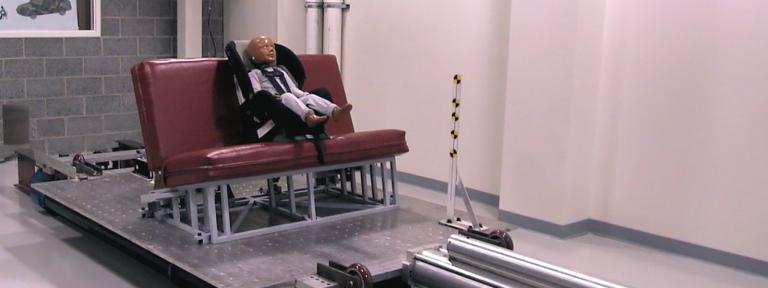
“There is a great need for this in industry right now to test the new standards. Thanks to support from Autoliv and TRW, Kettering has everything industry partners would need to assess their products.”
A new Q3s anthropomorphic test device (ATD) is the latest equipment addition that continues to make Kettering University’s Crash Safety Center one of the leading facilities in the country for vehicle safety testing and research.
The Q3s is an ATD (or crash test dummy) that represents a 3-year-old-child. It was developed to evaluate injuries to children in side impact crashes. Kettering’s Q3s is one of only four currently in use for industry testing in North America. Its use will be vital to companies attempting to conduct side impact studies in response to newly proposed Federal Motor Vehicle Safety Standards relating to child restraint systems, which were developed in collaboration with Kettering researchers. Kettering was able to acquire its Q3s thanks to support for corporate partners Autoliv and TRW.
“We ordered our Q3s almost two years ago and just recently received it,” said Dr. Janet Brelin-Fornari, Kettering University professor of Mechanical Engineering and director of the Crash Safety Center. “There is a great need for this in industry right now to test the new standards. Thanks to support from Autoliv and TRW, Kettering has everything industry partners would need to assess their products.”
Brelin-Fornari and the Kettering team in the Crash Safety Center have conducted research that has significantly contributed to reducing the risk of injury to children in crashes, including recently working with the U.S. National Highway Traffic Safety Administration (NHTSA) to develop a side impact test procedure for child restraint systems. That research helped inform new testing standards that were proposed by NHTSA. Kettering worked with NHTSA for more than two years and the Notice of Proposed Rule Making (NPRM) became public in 2014. The NPRM can be viewed online in the Federal Register.
The Crash Safety Center's role in this standard was the reproducibility and repeatability of the test procedure using a deceleration sled. This was achieved through testing of various manufacturers' products. All of Kettering’s individual test reports as well as summary reports with analysis are part of an NHTSA database. Kettering researchers also put together the test protocol for the deceleration sled, which will be a part of the final rule, which won’t be finalized until, at a minimum, the end of 2014. At that time, there is usually an 18-36 month lead-in for manufacturers to meet the standards set in the new rule.
“The research we’re doing at Kettering is affecting the national standards in crash safety for children in child seats,” Brelin-Fornari said. “Being able to work on a new federal standard is very unique, because they don’t change that frequently.”
Other research conducted in the Crash Safety Center includes work with Dorel Juvenile Group to develop a side impact test procedure to evaluate child seats in near-side impacts. The majority of fatalities in side impact collisions is to occupants on the near-side, or struck side, of the collision, according to NHTSA.
Kettering also partnered with Hyundai-Kia America Technical Center to conduct rear seat, small occupant side impact research.
“The type of testing we do is looking at the entire occupant protection system,” Fornari said. “We look at everything that’s happening within the vehicle during a crash -- including seatbelts and airbags -- the whole vehicle environment as one system.”
A unique aspect of the Crash Safety Center is that it not only provides a state-of-the-art facility for researchers, it also serves as an extension of the classroom for Kettering students, who get access to faculty doing research in the center and even get to witness some of the testing going on up close as part of their undergraduate experience.
“Our students are witnessing and even working on current, real-world crash safety issues because of this Center,” Brelin-Fornari said. “It allows us to bring our students into the facility every day. This is the only lab in world that we know of where students can get hands on experience like this at undergrad level.”
Since 2005, the Kettering University Crash Safety Center has conducted research, testing and field data mining involving adult and pediatric vehicle occupants in frontal, side, rear and rollover crash modalities. The expertise of Kettering’s research team is highly sought after for research, education and training throughout the mobility industry.
Equipment includes a full-scale deceleration sled, calibrated instrumentation including frontal and side impact ATDs, high-speed video and filming and analysis, deployment capabilities and 64+ channel data acquisition.
“The greatest thing about the research being conducted in the Crash Safety Center is that it is so interactive and practical,” Brelin-Fornari said. “This is not strictly theoretical research. It is hands-on, real-world testing being done that ultimately applies to anyone who rides in a car every day and leads to life-saving developments and innovations in vehicle safety.”